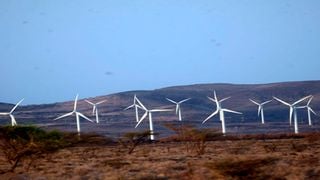
The turbines of the 310MW Lake Turkana Wind Power project in Laisamis Constituency Marsabit county.
Counties
Premium
Kenya’s surprise fastest growing counties are in arid north, Nyandarua bites dust
What you need to know:
- 17 counties, mostly located in the arid and semi-arid lands, have shouldered the growth of Kenya’s economy over the last five years.
- Regions have been expanding faster than the annual development of the whole country according to the bureau of statistics.
- Marsabit leads in shouldering growth thanks to the coming into effect of the wind power project.
The growth of Kenya’s economy over the last five years has been shouldered by 17 counties, most located in the arid and semi-arid lands (ASAL), that have been growing faster than the annual growth of the country’s economy.
This is according to the Gross County Report (GCP) 2023 that was released by the Kenya National Bureau of Statistics (KNBS) last week, and which shows the country’s annual Gross Domestic Product (GDP) growth averaged 4.6 per cent between 2018 and 2022.
The report has given a fresh insight into not only how much the country’s devolved units are contributing to the national cake, but which counties are growing their output at a faster pace than others.
The findings show that Kenya’s economy would be growing at a much slower pace were it not for 17 counties who are pulling the weight of 30 counties that are growing below the national average.
Marsabit, an ASAL county that has a population of just 460,000 people, grew at the fastest rate of 10.3 per cent during the period, which is more than double the national average growth rate.
The county’s sharp growth was attributed to the full commercialisation of the Lake Turkana Wind Power Project (LTWP) in 2019.
The 310-megawatt (MW) wind plant, which is Africa’s largest, is located at Loiyangalani.
“The sharp spike in Marsabit’s growth rate in 2019 could be attributed to the full commercial operationalisation of the 310MW-capacity Lake Turkana Wind Power Project located in the county,” said KNBS.
This was followed by Mandera (6.4 per cent), Isio lo (5.9 per cent), Tana River (5.9 per cent), Kajiado (5.9 per cent), Busia (5.8 per cent), Nairobi (5.7 per cent), Turkana (5.5 per cent) and Kitui (5.2 per cent).
The other counties that grew faster than the national average are Kakamega, Siaya, Samburu, Homa Bay, Tharaka Nithi, Kisumu, Migori and Vihiga.
However, a significant number of these rapidly growing counties still contribute a small share of the country’s total output, which means they still need more investment in their economies to compete with their larger peers.
This means that despite the fact that they are growing at a rapid rate, their total output of goods and services is still way below other counties mainly because of their low population and considerably less economic activities being carried out there.
“Several counties with a smaller contribution to GDP registered a faster growth rate over this period, indicating the potential narrowing of the gap with the dominant contributors,” said KNBS.
Devolution is playing a critical role in the emergence of these counties, many of which were largely marginalised prior to the promulgation of the new Constitution in 2010.
This is because since 2013, at least 15 per cent of the national revenues annually are shared by the 47 counties, which has brought critical services such as health much closer to citizens.
The construction of county headquarters and other amenities within the counties has led to the emergence of hitherto moribund towns which are now booming with economic activities such as trade, real estate, hospitality, banking and insurance, and construction.
“None of the counties registered a real GCP growth rate below 2.5 per cent in this period. The growth trends in these counties point out opportunities for private-sector investment,” says KNBS.
According to the report, Nyandarua, which is a major producer of agricultural crops, recorded the slowest growth rate during the five-year period.
The country grew at an average of just 2.7 per cent between 2018 and 2022, making it the only county to record an average growth of below 3 per cent.
This was followed by Meru and Kisii, which grew by an average of 3.1 per cent and 3.3 per cent respectively, while Kirinyaga and Baringo closed the five slowest growing counties with expansion rates of 3.4 per cent and 3.5 per cent respectively.
They were followed by Bungoma and Nyeri (3.6 per cent), Elgeyo Marakwet and Embu (3.7 per cent), Kericho (3.9 per cent) and Machakos (4 per cent).
Also Read: Why rich populous counties are protesting
Even as ASAL counties lead the way in output growth, Nairobi is still the country’s wealthiest county, with the size of its GDP being higher than that of 29 other counties combined.
Nairobi contributed 27.5 per cent of Kenya’s GDP over the last five years followed by Kiambu (5.7 per cent), Nakuru (4.9 per cent) and Mombasa (4.9 per cent), underlining the outsized influence that just four counties have on the country’s output.
Nairobi’s dominance has mainly been due to its control of key economic sectors, mainly manufacturing, construction and services.
About 37 per cent of the manufacturing and services sectors production between 2018 and 2022 happened in Nairobi.





